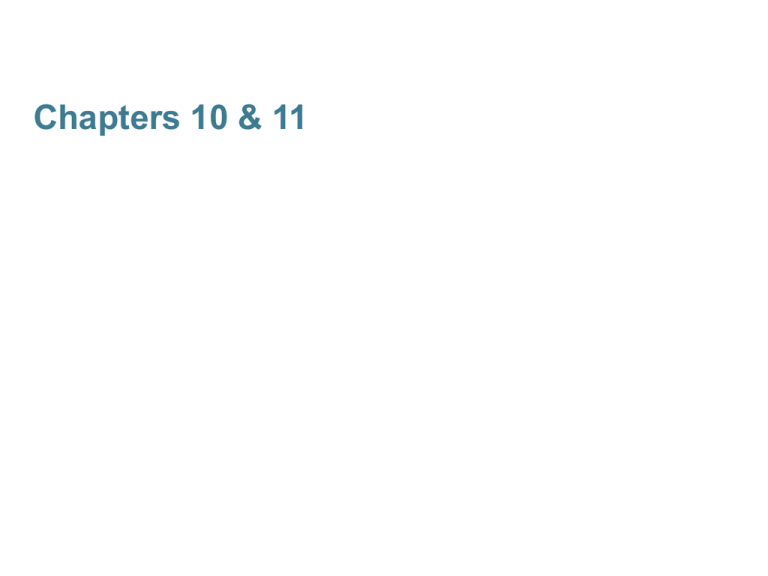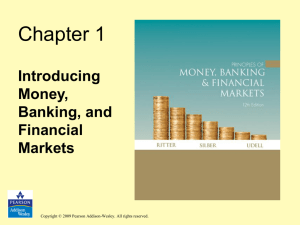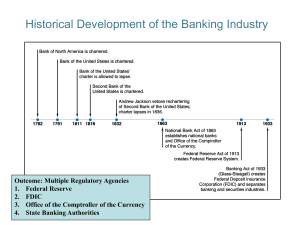
Chapters 10 & 11
Lessons from the Great Depression
During 1930-1933, some 9000 bank failures wiped out the
savings of many depositors at commercial banks.
Lessons learned (Glass-Steagall Act) :
• FDIC insurance
• Separation of the activities of commercial banks from
investment banks (1933-1999)
• Multiple regulatory agencies with overlapping jurisdictions
© 2004 Pearson Addison-Wesley. All rights reserved
10-2
Financial Innovation
Innovation is result of search for profits
Response to Changes in Demand
Major change is huge increase in interest-rate risk starting in 1960s
Example: Adjustable-rate mortgages
Financial Derivatives
Response to Change in Supply
Major change is improvement in computer technology
1. Increases ability to collect information
2. Lowers transaction costs
Examples:
1. Bank credit and debit cards
2. Electronic banking facilities
3. Junk bonds
4. Commercial paper market
5. Securitization
10-3
Avoidance of Existing Regulations
Regulations Behind Financial Innovation
1. Reserve requirements
Tax on deposits = i r
2. Deposit-rate ceilings (Reg Q till 1980)
As i , loophole mine to escape reserve
requirement tax and deposit-rate ceilings
Examples
1. Money market mutual funds
2. Sweep accounts
© 2004 Pearson Addison-Wesley. All rights reserved
10-4
The Decline in Banks
as a Source of Finance
© 2004 Pearson Addison-Wesley. All rights reserved
10-5
Decline in Traditional Banking
Loss of Cost Advantages in Acquiring Funds
(Liabilities)
i then disintermediation because
1. Deposit rate ceilings and regulation Q
2. Money market mutual funds
3. Foreign banks have cheaper source of funds: Japanese
banks can tap large savings pool
Loss of Income Advantages on Uses of Funds
(Assets)
1. Easier to use securities markets to raise funds:
commercial paper, junk bonds, securitization
2. Finance companies more important because easier for
them to raise funds
10-6
Banks’ Response
Loss of cost advantages in raising funds and
income advantages in making loans causes
reduction in profitability in traditional banking
1. Expand lending into riskier areas: e.g., real estate
2. Expand into off-balance sheet activities
3. Creates problems for U.S. regulatory system
Similar problems for banking industry in other
countries
© 2004 Pearson Addison-Wesley. All rights reserved
10-7
Structure of the Commercial Banking
Industry
© 2004 Pearson Addison-Wesley. All rights reserved
10-8
Ten Largest U.S. Banks
© 2004 Pearson Addison-Wesley. All rights reserved
10-9
Branching Regulations
Branching Restrictions: McFadden Act and
Douglas Amendment
Very anticompetitive
Response to Branching Restrictions
1. Bank Holding Companies
A. Allowed purchases of banks outside state
B. BHCs allowed wider scope of activities by Fed
C. BHCs dominant form of corporate structure for banks
2. Automated Teller Machines
Not considered to be branch of bank, so networks
allowed
© 2004 Pearson Addison-Wesley. All rights reserved
10-10
Bank Consolidation and Number of
Banks
© 2004 Pearson Addison-Wesley. All rights reserved
10-11
Bank Consolidation and Nationwide
Banking
Bank Consolidation: Why?
1. Branching restrictions weakened
2. Development of super-regional banks
Riegle-Neal Act of 1994
1. Allows full interstate branching
2. Promotes further consolidation
Future of Industry Structure
Will become more like other countries, but not
quite:
Several thousand banks, not several hundred
© 2004 Pearson Addison-Wesley. All rights reserved
10-12
Bank Consolidation and Nationwide
Banking
Bank Consolidation: A Good Thing?
Cons:
1. Fear of decline of small banks and small business
lending
2. Rush to consolidation may increase risk taking
Pros:
1. Community banks will survive
2. Increase competition
3. Increased diversification of bank loan portfolios:
lessens likelihood of failures
© 2004 Pearson Addison-Wesley. All rights reserved
10-13
Separation of Banking and
Other Financial Service Industries
Erosion of Glass-Steagall
Fed, OCC, FDIC, allow banks to engage in underwriting
activities
Gramm-Leach-Bliley Financial Modernisation Services
Act of 1999: Repeal of Glass-Steagall
1. Allows securities firms and insurance companies to purchase banks
2. Banks allowed to underwrite insurance and engage in real estate
activities
3. OCC regulates bank subsidiaries engaged in securities
underwriting
4. Fed oversee bank holding companies under which all real estate,
insurance and large securities operations are housed
Implications: Banking institutions become larger and more complex
10-14
How Asymmetric Information
Explains Banking Regulation
1. Government Safety Net and Deposit Insurance
A. Prevents bank runs due to asymmetric information:
depositors can’t tell good from bad banks
B. Creates moral hazard incentives for banks to take on too
much risk
C. Creates adverse selection problem of crooks and risk-takers
wanting to control banks
D. Too-Big-to-Fail increases moral hazard incentives for big
banks
2. Restrictions on Asset Holdings
A. Reduces moral hazard of too much risk taking
© 2004 Pearson Addison-Wesley. All rights reserved
10-15
How Asymmetric Information
Explains Banking Regulation
3. Bank Capital Requirements
A. Reduces moral hazard: banks have more to lose when have
higher capital
B. Higher capital means more collateral for FDIC
4. Bank Supervision: Chartering and Examination
A. Reduces adverse selection problem of risk takers or crooks
owning banks
B. Reduces moral hazard by preventing risky activities
5. New Trend: Assessment of Risk Management
6. Disclosure Requirements
A. Better information reduces asymmetric information
problem
© 2004 Pearson Addison-Wesley. All rights reserved
10-16
How Asymmetric Information
Explains Banking Regulation
7. Consumer Protection
A. Standardized interest rates (APR)
B. Prevent discrimination: e.g., CRA
8. Restrictions on Competition to Reduce Risk-Taking
A. Branching restrictions
B. Separation of banking and securities industries in the past:
Glass-Steagall
International Banking Regulation
1. Bank regulation abroad similar to ours
2. Particular problem of regulating international banking
e.g., BCCI scandal
© 2004 Pearson Addison-Wesley. All rights reserved
10-17
Bank Failures
© 2004 Pearson Addison-Wesley. All rights reserved
10-18
Why a Banking Crisis in 1980s?
Early Stages
1. Decreasing profitability: banks take risk to keep profits up
2. Deregulation in 1980 and 1982, more opportunities for risk taking
3. Innovation of brokered deposits enabled circumvention of
$100,000 insurance limit
4. i , net worth of S&Ls
A. Insolvencies
B. Incentives for risk taking
Result: Failures and risky loans
Later Stages: Regulatory Forbearance
1. Regulators allow insolvent S&Ls to operate because
A. Insufficient funds
B. Sweep problems under rug
C. FHLBB cozy with S&Ls
2. Huge increase in moral hazard for zombie S&Ls: now have
incentive to “bet the bank”
3. Zombies hurt healthy S&Ls
A. Raise cost of funds
B. Lower loan rates
4. Outcome: Huge losses
© 2004 Pearson Addison-Wesley. All rights reserved
10-19
Political Economy of S&L Crisis
Explanation: Principal-Agent Problem
1. Politicians influenced by S&L lobbyists rather than public
A. Deny funds to close S&Ls
B. Legislation to relax restrictions on S&Ls
C. Competitive Bank Equality Act (CEBA) of 1987 had
inadequate amount for bailout
2. Regulators influenced by politicians and desire to avoid
blame
A. Loosened capital requirements
B. Regulatory forbearance
© 2004 Pearson Addison-Wesley. All rights reserved
10-20
Financial Institutions Reform, Recovery
and Enforcement Act (FIRREA) of 1989
1. New regulatory structure: Office of Thrift
Supervision as new regulator, FDIC takes over
FSLIC fund
2. Resolution Trust Corporation (RTC) created and
given funds to close insolvent S&Ls: cost of $100$200 billion
3. Core capital requirement from 3% to 8%
4. Reregulation: Asset restrictions like before 1982
© 2004 Pearson Addison-Wesley. All rights reserved
10-21
Federal Deposit Insurance Corporation
Improvement Act (FDICIA) of 1991
1. FDIC recapitalized with loans and higher
premiums
2. Reduce scope of deposit insurance and too-big-tofail
3. Prompt corrective action provisions
4. Risk-based premiums
5. Annual examinations and stricter reporting
6. Enhances Fed powers to regulate international
banking
© 2004 Pearson Addison-Wesley. All rights reserved
10-22







